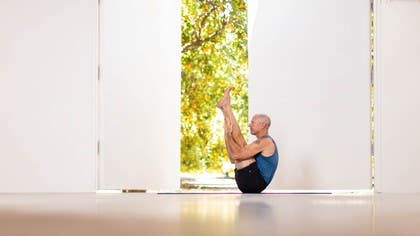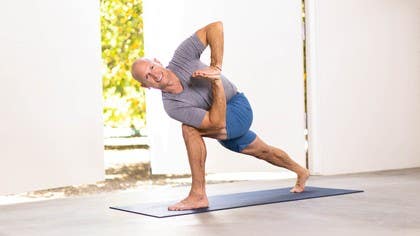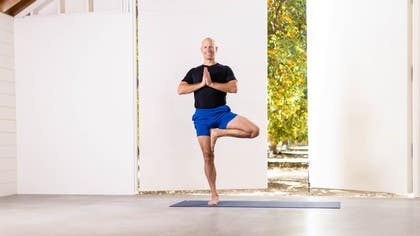Description
About This Video
Transcript
Read Full Transcript
Hello, and welcome. Great to be with you here today. In this lesson, we're going to focus on the core muscles, the center of the body. And specifically, we're going to focus on the lower abdomen and the positioning of the pelvis and how to bring strength to that area. Let's start out lying down with knees bent and take just a minute to relax, take a few breaths, let your blood pressure settle. And then if you'll join me in resting your hands on your lower abdomen just to bring a little awareness to that area, we're going to start with a few pelvic tucks. And by that, I mean press your waistband down towards your yoga mat and then let it go. Again, a pelvic tuck, push your waistband down towards the yoga mat and let it go. Do a few more with me. Waistband to the floor and relax. And I hope as you continue to do this, you start to feel that your abdominal muscles are helping to create this action. Try not to use your glutes. Try not to press the legs into the floor. Try to make it exclusively in the abdomen. Here's a way we can help get more clarity in that. If you place your palms right at the base of your thighs, like I'm doing here, and push firmly into your thighs, then try that pelvic tuck again and see how it goes. I think you'll feel the abdomen much more strongly. Try a few pelvic tucks with me here with the strength against the legs. Quiet glutes, quiet legs. Let's do about three more. Waistband to the floor. Relax. Two. And one more. And then let that go for just a minute. Our next pose will be a challenge in bringing up the leg to a tabletop. Let's bring up the right leg. Left hand still presses against the other thigh, and pelvic tucks again. This brings just a little extra challenge to the abdominal muscles. Pressing the waistband to the floor and releasing, we'll do about three more. Two. And one more. Right leg down, left leg up to tabletop, using your right hand against the right thigh, little resistance there, and again a few pelvic tucks. All of this to bring awareness to the lower abdominal muscles. Let's do about three more here. Two. And one more. Feet down, take a little rest. We'll raise the challenge yet again by bringing both legs up to tabletop. And use your hands now to grab onto the sides of your yoga mat. Gives us a little extra support and connection to the abdominals. Let's do a few pelvic tucks here. Press your waistband down into your yoga mat. And the key to this version is keeping the legs almost perfectly still. Try not to pull them towards your chest. Just the tip of the waistband into the floor. Let's do three more together. Two. And one more. And then feet down, take a little rest. Hopefully you feel some warmth in the abdomen now as we're starting out this lesson. Next we'll do a counter pose by tipping the pelvis backward just like before and rolling up into an easy bridge. No need to lift the chest here. This is just to open up the hips a little bit from the work we've done so far. Same action where the front of the pelvis is rolling towards the chest, waistband rolling back toward the floor. And then set the hips down. We're going to bring the knees into the chest. Give a little hug to your knees. Cross your shins.
Hold on down low in the shins and we're going to rock up to sitting. Sitting position. We'll keep the knees bent and we'll work for modified boat pose. To do that, start with your pelvic tuck. Roll onto the back of the sacrum. Grab the backs of the thighs and start to draw the feet towards you until they become weightless. When you found that position, bring the shins up parallel to the floor and we're going to hold here. Just a few more seconds and let it down to rest. The trick to this one, this pose, is to try to feel most of the work in the abdomen, not in the hip flexors here. That's what we want to get out of. Let's try it one more time. Hands behind the thighs, roll onto the back of the sacrum and then start to drag the feet in until they feel weightless and then hover the shins. Once again with that pelvic tuck in place, I feel most of the work here in the abdomen, much less work in the hip flexors. We'll extend the pose just a little by lengthening the arms and hold here. Keep that pelvis tucked back and then touch down. A little rest. We'll try for the full boat pose now. Fingertips to the floor for this one and once again a light pelvic tuck coming onto the sacrum for balance point. Draw the feet back. Using your hands as support, lift the shins and if you can, extend the legs fully. You could stay with the shins parallel to the floor if you like or join me in the full pose. Again with most of the work happening in the abdominal muscles. Holding here. Three, two, one and release. Good job. A little release pose, bada konasana. Feet together, knees wide and hands behind here. Lift up tall through the trunk and we'll relax and open the abdomen a little. And then release. We'll move into a plank pose and once again we'll take that technology, if I can call it that, of moving the pelvis, rolling the waistband, in this case straight up toward the ceiling and connecting to the abdominal muscles here. With that strength in place, we reach back to downward facing dog. A little side note in our downward facing dog, the upper arm bones and the shoulders, we want them to be lifted as we go deeper into the pose. Let's do a little leg pedaling. One heel lifts, the other heel presses to the floor. Couple more. Slowly opening up into the dog pose. And then full dog pose as you can, pressing your heels into the floor. Shoulder bones, arm bones lifting. Then we'll bring the attention back to the pelvis, tuck the pelvis again, waistband a little up towards the ceiling. We're going to create a roll back into plank. Holding here. Downward dog again. Awareness to the hips, to the pelvis, to the abdomen. We create that pelvic tuck and roll the spine as it pushes us into the plank pose. We'll do one more. Dog pose. Pressing the waistband up towards the ceiling. I'm doing that now. And that creates a roll, a wave into plank pose. Then bend the knees. Take a seat for just a minute and a moment to recover. Hopefully you can feel that warmth generating in the body and the abdomen and starting to get a clearer picture of how these muscles support the poses. We'll go back to plank pose. Connect with the abdominal muscles by raising the waistband again. And there I can feel that front support to the body. A breath in, a breath out. You're in dog pose. Feet together for this version. Lift your heels and that little pelvic tuck we've been working on. Helps us now to bring a knee, the right knee, into the chest in a three-legged plank. Back to dog pose. Touch the foot down. Same leg. Raise the heels. Little pelvic tuck. Right knee. Tucks deeply up into the chest. One more on this side. Heels up. A little tuck of the pelvis. Rolling through that spinal wave and this time right foot, plants between the hands. If you need to use your hands to bring that foot forward, by all means, you do that. And as before, we're going to work with that pelvic tuck waistband up to the ceiling. I'm going to do that now. There's that tuck. And now I can feel the hamstring of the right leg. The hamstring of the left are here to support me. We're lifting up into a crescent warrior now. Still with that action, that tuck in place, nothing aggressive, just to tilt back and I can feel all the support from the legs. Let's complete it by raising the arms. We'll hold for a few breaths. And then hands back down. We step to a plank. Connect to the support muscles, the abdomen, for chaturanga dandasana now. Halfway down. Getting the abdomen nice and strong. Hold. And then release all the way to the floor.
Point the toes. Take a few breaths as we move into an easy little baby cobra. Arching the spine up from the floor. And then chest down. Tuck your toes. We'll press up to dog pose. Over in your dog pose, shoulder bones, arm bones, lifting away from the mat. Though we're moving the body closer, the trunk closer to the floor. Feet together. Raise the heels. And now we're working with the left leg. Start with your pelvic tuck and then left knee draws up to the heart. Back to dog pose. Feet on the ground. Heels up. Tuck the pelvis and then bring the knee again into the heart. One more time. Heels up. Tuck the pelvis. Draw that leg up and then this time we go to that lunge position. Take a minute here. You'll gently tip the waistband up to the ceiling and you can see how my body changes its position a little bit and creates the support for the pose. Then with that support in place, crescent warrior. Arms come above the head. Take a few breaths here. Feeling how the lift, the front of the pelvis, engages the core, engages the thigh muscles and then hands down. We'll step back to the plank and then with support in place of the abdomen, we'll come halfway down to Chaturanga. Holding there. Release the body all the way down.
Take the toes and one more time, a baby cobra. Let the chest down. Tuck your toes. Dog pose. Take a few breaths here and then walk with me to the front of the mat and we'll stand in Tadasana. We can do the same things we've done in the previous poses and feel how the support system works here. To start, just like we did on the floor, we're going to gently tip the waistband back. A few things I want you to feel. As the waistband goes back, you start to feel a muscular engagement in the hamstrings and there's a downward pressure through the heels. The front of the body you feel uplifting and this creates a cycle, I'm going to call it energy, a cycle of energy through the body. Uplifting all the way through the crown of the head and rooting down through the floor. Holding that pelvic tuck, waistband movement in place, raise your arms above the head. See if you can keep that feeling all the way through the arms. Up through the front, strongly grounded through the back and through the heels. And then arms down to rest. Chair pose. We'll start with an easy bend of the knees, hands on thighs, and like we did on the floor, we're going to push, push into thighs to create a little resistance. Then we'll gently tuck the pelvis. Nothing aggressive here. We don't want to end up in a pose like this, but with the hands pressing against the thighs, we're going to gently tuck the waistband back. And now once again, I can feel those hamstrings strongly supporting the pose. Keeping those actions in place will raise up the arms alongside the ears and now we can start to take the pose deeper and deeper. You'll see my knees are in front of my toes. That's totally okay to do. Holding there, building heat in the body and then come up and release. Relax your legs a minute. Take a breath or two. Next, we'll use this to challenge a balancing pose. Set up your pelvic tuck. Feel the front of the body lifting, supported and grounded through the heels. We're going to drop the right leg first and hold behind the knee. And when we do that, we want to feel that we still have that gentle tucked position in place so that we have all the support muscles at our command. Then if you're feeling like you've got the balance to extend a little further, as you extend the leg, that gentle pelvic tuck in place. And then bend the knee and touch down. We'll take it to the second side. Left leg, but first, gentle tuck. Feel the support of the abdomen, the lift of the abdomen and hold behind the leg. G up to the front and down to the back. And if you feel like you've got the balance, let's try extending the leg. And again, the support for this extension comes from that gentle turn of the pelvis, the lift of the abdomen and the downward support to the leg. Bend the knee and release. We'll go feet together and we're going to move back into downward facing dog through Vinyasa. Arms up, nice breath in. Strong legs, forward fold. Gently look forward. Step back to your plank. We'll pause there in plank. The gentle tuck of the pelvis that we've been working on connects the whole front abdomen for support. Breath in and breath out, Chaturanga, halfway down. We'll try full up dog now. Press up through the arms, point the toes back. And here still, we can use that same lift in the front of the body to create more height and pose. Pull back to downward dog. Take a few breaths here, arm bones lifting. Next, let's explore a few more core poses by coming forward into a plank.
Gentle pelvic tuck waistband up towards the ceiling, feel the support of the abdomen. And we'll start by tipping the heels off to the left, down to the mat. Turn open so we're inside plank. Here again, we have a gentle tuck, waistband back, and if you can, top arm up. Holding here, feel the support in the side of your body. And then come back down through a dog pose. And then second side, heels up, rolling forward into a plank. Tip the heels off to the right side. Gentle tuck of the pelvis, waistband moving back. Holding here, taking a few breaths. And then we'll place the hand down, dog pose. And then let's take a rest in child's pose. Head down to the mat if you can. You're also welcome to fold your arms, make a little pillow and take a good rest. Let's come out of child's pose and take a seat with legs forward. We're going to try a deeper version of boat pose now that we've really got the core ignited and ready to rock. We'll start by rolling back onto the hips again, onto the sacrum. And drawing the legs in like we did earlier, wrap the hands around the shins and we're going to snuggle everything into the chest and the chest into the legs. One compact pose right here. Holding for just a second and then set the feet down and rest. Now we can repeat that pose and we'll do that to enter in and we'll see if we can take it just a little bit further. Once again, rolling back onto the sacrum, little pelvic tuck, draw the legs back and into the body and this time hold behind the thighs. If you would like, you can take the legs up with me to your level, maybe even up to straight, walking the arms up the calves and finally the ribs also into the legs. Challenge your balance, challenge your core. Holding there and then release and we'll recover and cross legs for just a moment. Relax the legs, lift up out of the abdomen and then from here we'll take pigeon pose. Left leg forward, right leg back. Even in these seated poses we can use the same movement of the pelvis to actually offload stress and strain from the hip and especially the knee where people can run into trouble in pigeon pose. To do that, once again we're going to gently tip the pelvis back. To help with that, we'll extend the right leg straight backward a little bit and I can feel now I'm more on the back of my left hip. Then keeping the left hip firmly to the floor, we can come down any amount that works for you. You can rest your head on your arms or just hover above if you need. The magic in this is that I sit more on the hip rather than the middle of the thigh or even on the knee which can put torque in this forward knee. Now we get the stretch where it needs to be in the hip. We'll gently come up and transition to the other side. Press back to a plank, sweep the right leg forward, and we'll use the same ideas here. Gently tipping the waistband back a little bit and we can reach back with the left leg. I'll do that now. You can see how I roll back onto that right hip. Now my weight is born here rather than in the middle of the thigh and that helps me protect the knee. Keeping heavy onto that right hip, I can bring the hands down and join me at a level that works for your body. If you'd like to rest the head down, if that's easy for you to do, please do that or stay at a level that works for you. Take a few slow, easy breaths here in and out through the nose if you can. Then we'll come up and lift into the plank pose into downward dog. Arm bones are lifting, relax your head, relax your neck. Then let's come down again to a seated position. This time with wide legs. In this pose we're going to be working off to both of the legs. To start, we'll twist off just a little bit to the side here. What I want you to see specifically is that I can take a hand underneath my hip. That's really important for the safety of the spine in these poses. We go deeper. Let's just try that much. By turning off to the left leg, I've pushed down on the heel and lifted this hip. Then let's go back to what we already know. A gentle, gentle tuck of the pelvis back because again if I do too much, that's not going to work for the pose.
Just a gentle movement back so I feel the abdominal muscles become alert. Turn off to the left leg and we'll begin a journey toward the leg. As you go down, the tendency for us is to pull, pull, pull, pull, pull forward but you'll start to really feel that aggressive pull on the hamstring. Instead, have a little resistance there with your pelvic action we've been learning in this class today. Take it to a level that works for you and if you can bring the head down, go for it. Take a few breaths at your level. Then gently up. Pause and center for just a moment. Then take it to the other side. Turning to the right, first most important thing is that little lift here of your left sitting bone. That helps bring the pelvis a bit more along in the pose and helps to not overstretch the spine. Then before we go for the leg, just that very slight pelvic tuck waistband back a little bit. Heading down for the leg now. You can test it for yourself and see if you pull yourself forward, there's that hamstring over pulling again. As we progress a little further into the practice, the poses shouldn't create those straining pulls on the muscles anymore. It should actually be quiet, comfortable and even if that means you're up here, no problem. You can still work that energy in the pelvis and be perfectly good up here. Take it to your level. Hold for just another breath or two at your level and then come up, come to center. We'll lean back to bring the legs in one at a time and turn back toward the floor. Rest down on your back. Take a few breaths here and with me, we're going to kind of go back to the beginning and feel what we started with, that gentle touch of the waistband down to the mat. I'm going to be using these ideas and classes together coming up, so I want you to be really familiar with that area. Then another bridge pose. We'll take the hands to the mat, gently tuck the waistband back and come up to an easy bridge. You can tuck the shoulders a little under. This time the chest will come up a little with us and we'll maybe call it a three-quarter bridge. We're not going for the stars here, just an easy bridge to reverse us out of the forward bending we've been doing today. Front of the abdomen is gently drawn up toward the heart, sacrum and back of the hips toward the back of the knees. It's that circle of energy again. Hold here and then rest your hips down. Release the shoulders and we'll do one more. Tip the waistband back, use the strength of the legs to bring up the hips. Tuck your shoulders just gently behind the back. And as before, we roll the front of the pelvis a little towards the heart, back of the hips towards the knees. You can press the arms a little bit more here and raise up to a level you're comfortable with. And then release down, release the shoulders and pause. We'll just rest here taking a few breaths and we're going to enter into Shavasana but use the same movement of the pelvis to help create a really quiet, quiet, passive abdomen. And this is where deep rest can really come from is the quietening here. I mean there's a reason why mom touches our belly when we're young to quieten us down. To start that, let's walk the feet out just a little bit away from the hips. If you raise the toes just a little bit and dig the heels down and push them away, you'll feel that pelvic tilt come on to play but it's more passive. It simply drops the abdomen down. That's what the feeling I'm going for here is. You feel your low back gently soften into the floor. And then ever so slowly you can walk your feet a little bit out, a little bit out, a little bit out until you get down almost to the end and rather than letting your legs scoot out to flat, gently let your knees soften into the floor. And that helps keep as much passivity in the abdomen as you can. Drop the arms out to the sides and very slowly take the energy away from the legs. Let them roll out and become quiet. And then slowly closing your eyes, let your attention draw into the abdominal area and feel the rise and fall of your breath there. And while you're resting in the Shavasana, let your attention just reside in that quiet abdominal area, letting it sink further and further as it will. All the energy is out of the legs. No more tension there. The fingers, the arms, shoulders and neck, all soft. And breathing quietly in and out through the nose. If you feel like you'd like to stay a little longer in your Shavasana, please do spend as much time in this pose as you like. If you're ready to come up, wiggle your hands, wiggle your toes and we'll bend the knees one at a time and turn softly onto your right side for a moment. We'll pause there. You can support your head with your hands and then use your hands to push yourself up into a sitting position. Great to be with you in this routine today. Again, with a focus in the core muscles. I look forward to seeing you in the next lesson.
Advanced Basics
Comments
You need to be a subscriber to post a comment.
Please Log In or Create an Account to start your free trial.






















